
Università degli Studi di Pavia
Centro Interdisciplinare di Bioacustica e Ricerche Ambientali
Via Taramelli 24 - 27100 Pavia - Italye-mail : cibra@unipv.it
CIBRA Digital Signal Processing PAM Workstation
The development of a DSPW suited for bioacoustical studies began at CIBRA in 1980 with bulky and expensive laboratory equipment; ten 10 years later it was possible to design an affordable and easy transportable equipment for field use (DSPW History, DSPW 1991-1996). The design of the current DSPW suited to PAM needs began in year 1997 for the surveys to be carried out within the SOLMAR Project. Year by year new functions have been incorporated to accomplish the continuously expanding requirements of both PAM research and mitigation projects.
DSP PAM Workstation Development stage 2004-2005.
Passive Acoustic Monitoring (PAM) is a
powerful tool to be used for (a) expanding knowledge about
marine mammals’ distribution, (b) monitoring underwater
noise, (d) monitoring critical habitats, (e) evaluating
the effects of sound exposure on animals’ behaviour, (f)
implementing mitigation policies by detecting animals
within or approaching a possibly dangerous sound exposure
area.
To support the Acoustic Risk Mitigation Policies being
developed by many national and international civil and
military organizations the PC based Sound Analysis
Workstation developed at CIBRA was largely improved and
extensively tested to provide an affordable and flexible
tool for wide band acoustic detection and monitoring of
marine mammals and terrestrial animals.
Specific
software has been developed for the workstation, to
accomplish the many different requirements of both
mitigation and research needs. It provides detection,
processing, storage and plotting capabilities and it can
be used for both wide area surveys and local monitoring
needs.
The package includes software for 1) recording and
analyzing sounds received by up to 8 wide band sensors, 2)
manage a sonobuoys’ radio receiver, 3) recording and
distributing NMEA navigation data, 4) logging and
classification of acoustic contacts, 5) logging visual
contacts, 6) sharing data among a network of PCs, 7) plot
georeferenced data on a GIS.
Acoustic data is stored in standard wav files, in user defined time cuts; each cut is time- and geo-referenced to be easily linked to other georeferenced data.
The system is modular and flexible to be adapted to different contexts and needs. It optimally requires at least one PC dedicated to sound recording and one to GIS and navigation; additional networked PCs can be used to distribute processing and visualization needs. Depending on the chosen acoustic interface and on storage capabilities, 2 to 8 channels with bandwidth up to 100 kHz can be continuously recorded 24 hours/day. A further option allows to record one channel up to 400 kHz bw.
The system can be based either on desktop or laptop PCs.
A downsized version, based on a single laptop PC, powered with external batteries and a photovoltaic panel, can be easily used on small boats or for easy recording in the field.
A set of sensors (wideband towed arrays, stationary hydrophones, sonobuoys), based either on commercial or designed for the purpose components, has been also designed, assembled and tested to set up a self contained, lightweight, easy to install and use, affordable complete equipment for passive acoustics research and mitigation needs.
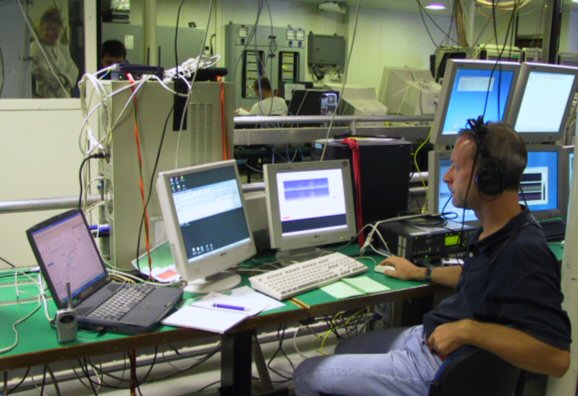
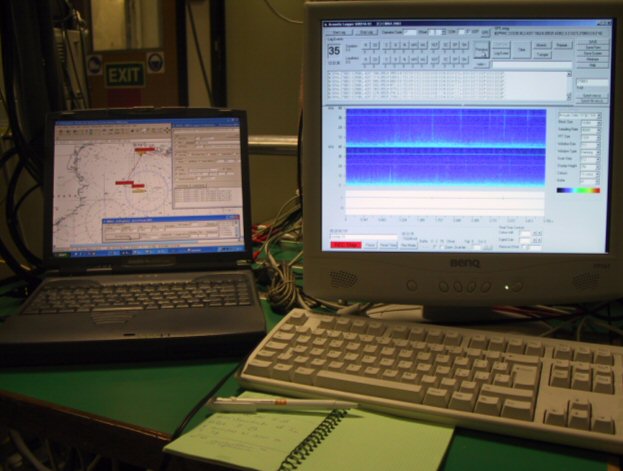
The PAM system in SIRENA 2003 was
based on a network of PCs exchanging data through UDP.
A desktop PC with dual display for sound recording (8
channels, 96 kHz sampling), analysis, classification and
data logging; a notebook PC for the navigation display;
other PCs on the network received data to plot acoustic
contacts on a GIS.
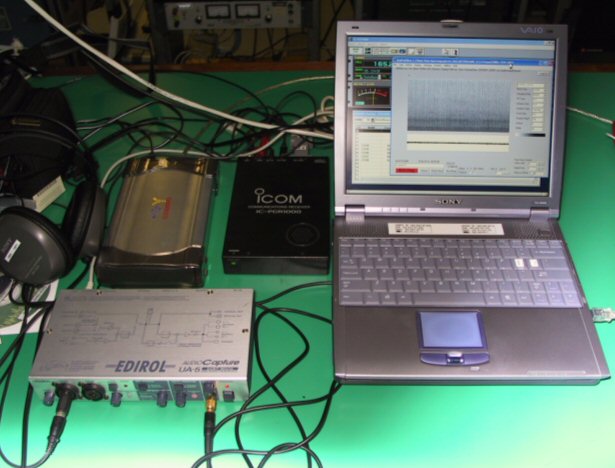
The Portable version of the PAM Workstation with the Sonobuoy radio receiver and the sound acquisition interface (Edirol UA5, two channels, 96 kHz sampling).
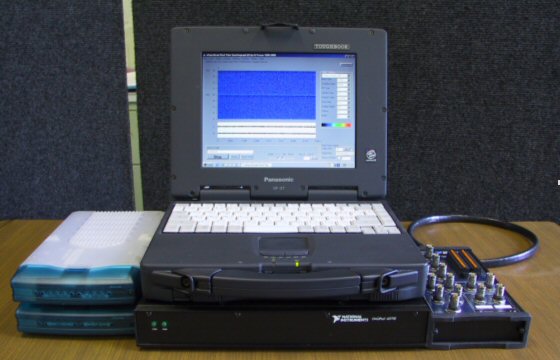
The Portable PAM Workstation with the National Instruments high frequency signal acquisition system and external hard disks to accomplish continuous wideband recording up to 1 MHz sampling rate.
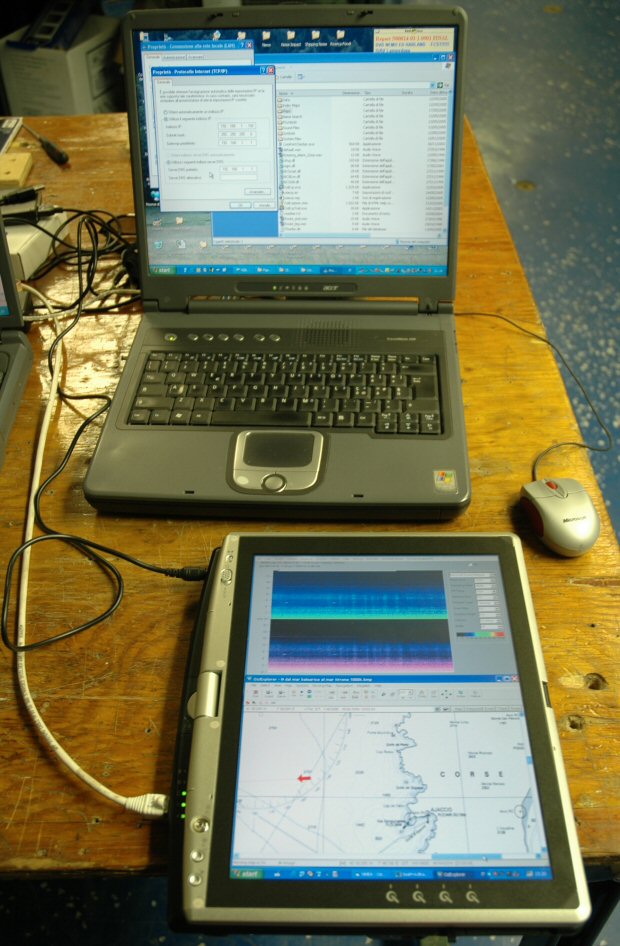
The latest implementation of the Portable PAM Workstation (2005) includes a wireless Tablet PC to allow wireless data logging, navigation and spectrogram display in a networked PAM configuration. A desktop or a notebook PC interfaced to the acquisition system are used to acquire, store and distribute acoustic and navigation data. The tablet PC can also work alone if connected to a GPS and to a sound interface unit (2 channels, 96 kHz sampling; 8 channels, 192 kHz smapling; 1 channel 1 MHz sampling).
The PAM Workstation on a katamaran for a survey in the Ligurian Sea in 2005.
Acknowledgements
The research has been carried out within the NURC SOLMAR Project with ONR Grants N00014-99-1-0709, N00014-02-1-0333, and N00014-03-1-0901.
References
PAVAN G., FOSSATI C., MANGHI M., PRIANO
M., 2004. Passive acoustics tools for the implementation
of Acoustic Risk Mitigation Policies. In “Proceedings of
the workshop on Active sonar and cetaceans”, 17th ECS
Conference, March 2003, P. G. H. Evans and L. A. Miller
Eds., EUROPEAN CETACEAN SOCIETY NEWSLETTER NO. 42 –
SPECIAL ISSUE: 52-58.
PAVAN G., MANGHI M., 2004. Tools for underwater noise
monitoring, marine mammals’ surveys, and acoustic risk
mitigation policies’ implementation. Marine Mammals
Commission, USA. Published online http://www.mmc.gov
CIBRA Home Page
Updated October 2005.